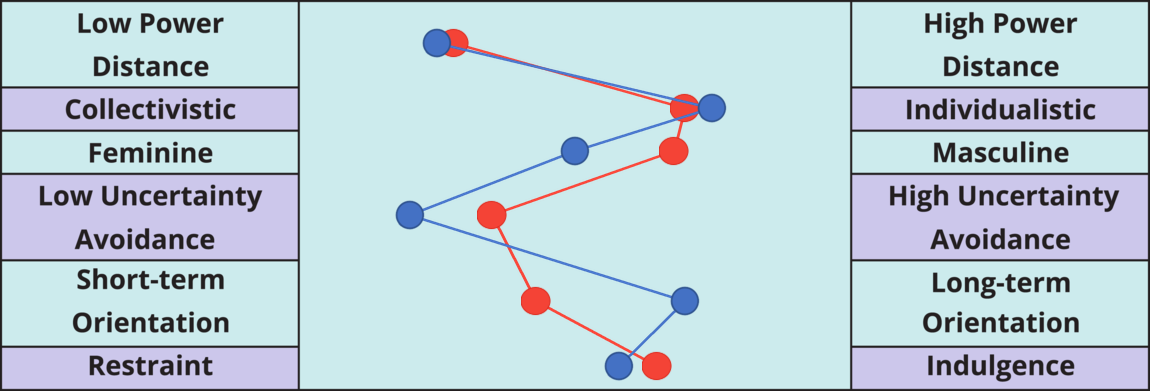Cultural Dimensions Test
You are here because one of your friends linked you to their Cultural Dimensions Test result:
Take the TestResults:

Your friend prefers:
- A low power distance.
- Individualism over collectivism.
- A balance between masculinity and femininity.
- Low uncertainty avoidance.
- A long-term orientation.
- A balance between restraint and indulgence.
Your friend's cultural dimensions are the most like those of Ireland.
Take the TestExplanation of Cultural Dimensions:
High vs. Low Power Distance: Refers to the beliefs regarding the proper distribution of power in a society. It expresses how much less powerful members of a community should accept that power is allocated unequally. How a society deals with social inequality is the main concern in this dimension. People in civilizations with high power distance accept hierarchical structures where everyone has a place, and no further reasoning is necessary to justify that hierarchy. In comparison, societies with low levels of power distance work to equalize power distribution and demand tangible reasons for power inequalities in the government of their countries.
Individualism vs. Collectivism: Indicates how the interests of the individual are weighed against the interest of the community. A loosely-knit social structure in which people are expected to look out for and check in primarily with themselves denotes a high level of individualism. By contrast, cultures with low levels of individualism are attuned toward the group and typically feature a closely-knit social structure in which people look to their relatives, countrymen, coworkers, and other members of their communities when determining what course of action they will take.
Masculinity vs. Femininity: Cultures high in masculinity tend to revolve around success, competition, and rewards. By contrast, cultures low in masculinity concentrate on values like nurture, modesty, and empathy. High-masculinity cultures often produce more assertive and decisive leaders, whereas low-masculinity cultures tend to produce more agreeable, inclusive, and compassionate leaders.
High vs. Low Uncertainty Avoidance: Measures how comfortable a culture is with ambiguity and uncertainty. High uncertainty avoidance cultures uphold strict moral and behavioral standards and tend to frown on unconventional behavior and ideas. They want the future taken care of and planned for according to what has been proven to work in the past. By contrast, low uncertainty avoidance cultures are more tolerant of unusual ways of doing things and are not as disapproving of ambiguity.
Long vs. Short-term Orientation: Measures whether a culture aims for long-term goals on the basis of how the world is projected to change or prefers to achieve short-term goals using how things have been up till now as a guide. Cultures with a long-term orientation are future-focused and promote thrift and investments that take a long time to come to fruition. In contrast, cultures with short-term orientation uphold long-standing traditions as a way of ensuring stability and tempering the speed of social change.
Indulgence vs. Restraint: Measures the degree to which cultures attempt to regulate their impulses toward gratification. Cultures high in indulgence encourage pleasure and enjoyment as innate human desires associated with taking pleasure in life and having fun, whereas cultures with a restraint orientation frown on the satisfaction of desires and attempt to control enjoyment through social rules and taboos.
References
- Hofstede, G. (2001). Culture’s Consequences: Comparing Values, Behaviors, Institutions, and Organizations Across Nations. Second Edition, Thousand Oaks CA: Sage Publications.
- House, R. J., Hanges, P. J., Javidan, M., Dorfman, P. W., & Gupta, V. (2004.), Culture, Leadership, and Organizations: The GLOBE Study of 62 Societies, SAGE Publications.
- Steers, R.M. et al. (2013). Management Across Cultures: Developing Global Competencies. Cambridge University Press.
GET THE FULL STORY
Become a lifetime member with a one-time payment
WHAT YOU GET
Access to premium, members-only tests
Access to all of our eBooks (value $44.94)
Access to 100s of premium articles
Access to 100s of premium type assessments
Access to premium infographics
New content continuously added
Become a member